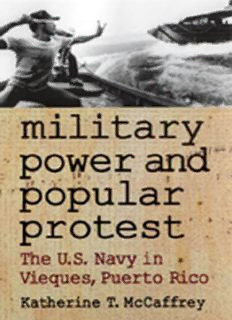
Military Power and Popular Protest: The U.S. Navy in Vieques, Puerto Rico PDF
Preview Military Power and Popular Protest: The U.S. Navy in Vieques, Puerto Rico
Preface i Military Power and Popular Protest ii Preface Preface iii Military Power and Popular Protest The U.S. Navy in Vieques, Puerto Rico Katherine T. McCaffrey Rutgers University Press New Brunswick, New Jersey, and London iv Preface Library of Congress Cataloging-in-Publication Data McCaffrey, Katherine T., 1966– Military power and popular protest : the U.S. Navy in Vieques, Puerto Rico / Katherine T. McCaffrey. p. cm. Includes bibliographical references and index. ISBN 0-8135-3090-3 (cloth : alk. paper) — ISBN 0-8135-3091-1 (pbk. : alk. paper) 1. Vieques Island (P.R.)—History—20th century. 2. Protest movements— Puerto Rico—Vieques Island—History—20th century. 3. United States. Navy—Target practice—History—20th century. 4. Civil-military relations— Puerto Rico—Vieques Island—History—20th century. 5. Government, Resistance to—Puerto Rico—Vieques Island—History—20th century. I. Title. F1981.V5 M33 2002 972.95'9—dc21 2001048838 British Cataloging-in-Publication data for this book is available from the British Library. Copyright © 2002 by Katherine T. McCaffrey All rights reserved No part of this book may be reproduced or utilized in any form or by any means, electronic or mechanical, or by any information storage and retrieval system, without written permission from the publisher. Please contact Rutgers University Press, 100 Joyce Kilmer Avenue, Piscataway, NJ 08854–8099. The only exception to this prohibition is “fair use” as defined by U.S. copyright law. Manufactured in the United States of America Preface v For Howard and our children, Benjamin and Julia vi Preface Preface vii Contents Preface ix Acknowledgments xiii Acronyms and Spanish Terms xvii Introduction 1 One A Strategic Colony on the Margins of the Empire 17 Two Cultural Identity in Vieques 43 Three The Fishermen’s War 67 Four We Are a Species in Danger of Extinction: The Aftermath of the Fishermen’s Crusade 98 Five Organizing for Change 124 Six From Pescadores to Rescatores: The Resurgence and Transformation of Struggle 147 Seven The Battle of Vieques 173 Notes 185 References 197 Index 207 vii vviiiiii PCroenftaecnets Preface ix Preface When I first traveled to the Puerto Rican island of Vieques in the summer of 1991, the U.S. Navy, at war with squatters, had secured the contested bound- aries of its western perimeter with tall cyclone fences, rimmed with coils of razor wire. Behind navy fences stood a majestic old Ceiba tree. The Ceiba re- calls the forest that once covered Vieques before sugar cane fields and navy bulldozers cut across the terrain. Its massive, buttressed root system has an- chored this huge tree against the fury of countless tropical storms. The Ceiba came to symbolize for me the beauty and resilience of the people who struggle to live on this island. Ten years later the fences that delimited the Ceiba were torn down. In re- sponse to a widespread popular movement, the navy relinquished one-third of its landholdings in Vieques. Under an agreement reached by U.S. president Bill Clinton and Puerto Rican governor Pedro Rosselló, eight thousand acres of land under military jurisdiction returned to civilian authorities in June 2001. The reversion of land suggested how dramatically the course of Vieques’s his- tory had changed in one decade. I first came to Vieques with the support of an Alexander C. Naclerio Award from the City University of New York Graduate School for research in hous- ing and urban studies and a graduate research fellowship from Intercambio, the City University of New York–University of Puerto Rico exchange program. Because I was interested in squatting as a social movement in Puerto Rico, a number of colleagues had suggested I look at Vieques. Just two years earlier, in 1989, two hundred families on the island had seized eight hundred acres of land under the jurisdiction of the U.S. Navy and built an organized settlement that was ultimately wiped out later that year by Hurricane Hugo. I was intrigued ix
Description: